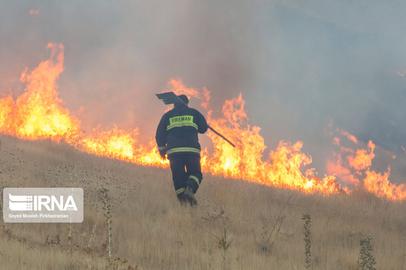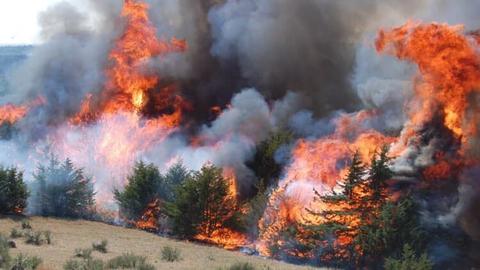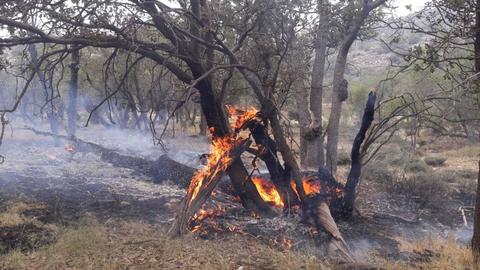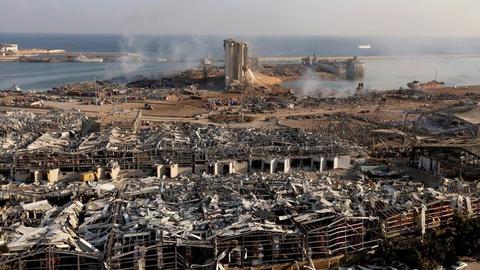Four volunteer firefighters from the same family have died in a wildfire in Hayghar Canyon in Firoozabad county, Fars Province, the local governor has confirmed.
The victims have been named as Nasser Behzadi, 46, his son Reza Behzadi, 19, and his 18-year-old nephew Hamed. Nasser Behzadi’s brother-in-law, whose name and age have not been made available, also lost his life.
The four died while battling a fire that had ripped through an area known as “Iran’s Grand Canyon," 35 kilometers southwest of Firoozabad. They were part of a team working for an environmental charity in the region.
The tragedy coincided with the news that Iran had sent support, including specially-equipped helicopters, to deal with the much more widely reported fires in neighboring Turkey.
Governor Hossein Argiv and Mehdi Gholami, head of Fars province’s Natural Resources Protection Agency, said the fire started at noon on Monday, August 2, and was contained by nightfall. But a new band of wind meant the wildfire began spreading again on the morning of Tuesday, August 3. As the fire raged, a tornado then ripped through the area, forcing the firefighters to flee for their lives. Three of them died at the scene, Argiv said, and the fourth man sustained serious injuries and later died.
Eyewitnesses say that immediately after the fire broke out the provincial government asked Bushehr and other neighboring provinces to provide helicopters to help fight the fire; four helicopters arrived, but only on August 3.
Videos shared online show the horrifying scale of the fire and the devastation of the lush and beautiful canyon. “Because of the strong winds the fire is expanding faster and volunteers are facing two problems at the same time,” tweeted an eyewitness using the handle “Iranian Plateau”.
Some locals say officials made false claims that the wildfire was under control, leading to further devastation and depriving the area of much-needed help, equipment and expertise. Volunteers were left to deal with the fire on their own, and local authorities did nothing to protect them, leaving them trapped as the wind changed direction, eyewitnesses say.
“Since Monday, 60 forest rangers from Fars province, accompanied by a number of volunteers, have been working to extinguish the fire,” environmental agency official Mehdi Gholami said in an official statement. “All forest rangers are clad in special fireproof clothing and a number of volunteers have also been given protective clothing.” But one volunteer at the scene told IranWire that no local people who had given up their time to contend with the fire had been provided with protective equipment.
Although the source of the recent fire has not been identified, wildfires routinely break out in both forests and open pastures in the Zagros mountains. This increases during the summer months, when fires break out almost daily. As with the recent crisis, volunteers and local firefighters are forced to try to manage the situation without access to sufficient and necessary equipment.
One environmental activist told IranWire that most wildfires in Iranian forests, especially in the Zagros mountain range, are started deliberately. He added that, despite efforts by government-employed units, relief workers and volunteers, the current fire has yet to be contained.
Anger as Iranian Firefighting Planes Deployed to Turkey
There has been mounting anger over the handling of the fires, and in particular over Iranian officials’ decision to send Revolutionary Guards-owned aircraft to Turkey to deal with devastating fires there — a move many Iranians have found baffling, given the severe shortage of manpower and equipment in their own country. There was widespread criticism on social media, and many blamed government agencies, accusing them of negligence and incompetence.
On Saturday, July 31, Turkish president Recep Tayyip Erdoğan reported that 13 firefighting aircraft, including planes from Ukraine, Russia, Azerbaijan and Iran, had been deployed to help fight at least 130 wildfires that have devastated at least 30 provinces near the Mediterranean coast of Turkey and spread to Greece. Iran’s firefighting aircraft were first unveiled in 2018, but they have never been deployed to fight wildfires in Iran.
Anger grew as environmental activists pointed out another recent fire in the western province of Iranian Kurdistan that had not been dealt with adequately. “From July 23 to July 31, Marivan forests in the area of Darreh Varan were hit with extensive wildfires,” tweeted the Chyra Green Organization, a society of environmental activists. “During all this time, members of the Chyra society and local people worked around the clock to contain the fire. In several stages and within a few days, this wildfire seriously and permanently damaged many mature trees in the area.”
Another fire raged in Siyakh Darengun and Tang Khani in Fars province at the same time. Again, a group of environmentalist volunteers rushed in to help contain it.
For its part, Revolutionary Guards spokespeople said they had simply been carrying out orders.
“Fires, floods, droughts, insecurity and epidemics are not restricted to geographical boundaries,” tweeted Mohammad Farazmand, Iran’s ambassador to Turkey, on August 2 in response to criticism. “If we do not help each other the world will not be a safe place for our children. With their participation in fighting fires inside and outside the country, the selfless firefighters of our defense ministry are ambassadors of friendship and human responsibility.”
“Wish we could have as much sympathy for our own forests,” responded one person on Twitter.
On Sunday, August 1, the Turkish defense ministry tweeted a photograph of an Iranian Ilyushin 76 airplane that had been dispatched to Turkey. The plane, which, according to the ministry has capacity to transport 30 tons of water, was photographed at a military base in southern Turkey. Until it was shared on Twitter, environmental activists say they had no idea that Iran even owned such firefighting equipment.
People are Dying Because of Lack of Investment
Forest rangers and environmental groups and charities that fight wildfires repeatedly emphasize that untrained and unequipped volunteers must not endanger themselves by working on the frontline. In recent years, every individual who has been killed trying to put out wildfires in Iranian forests has been a volunteer and, according to the legal office of Iran’s Environmental Protection Agency, this number is growing year on year.
In 2020, a law was passed to give greater protection to forest rangers. It initially included a provision from the Environmental Protection Agency that meant volunteer firefighters would be insured, but this provision was blocked by the Guardian Council, stating that it would require funds it was not willing to approve.
In the two first months of summer 2020, five volunteers lost their lives fighting wildfires in Iranian forests and a number of others were injured. But local people say there is no choice: people have to volunteer because there is either nobody else to tackle the fires, or when professional relief forces arrive on the scene they lack sufficient equipment.
An eyewitness to the recent fires at Hayghar Canyon told IranWire that the shortage of relief forces and equipment, including helicopters carrying water to extinguish fires, coupled with a lack of any crisis management strategy, have made controlling fires in Fars province impossible.
In April, Iran’s National Biological Diversity Convention Office announced that in the last 16 years 1.645 million hectares of Iranian forests and pastures have been destroyed by fire. In 2020 alone, more than 21,000 hectares of Iranian forests were destroyed, killing animals, wildlife, plants — and in many cases, costing human lives. And since the start of the Iranian new year on March 21, more than 43 wildfires have caused damage to Iran’s forests and pastures, some of which were set deliberately. In the absence of firefighting aircraft and helicopters, volunteers are forced to use shovels, sticks and buckets to fight fires.
Over the years multiple environmental experts have outlined the damaged caused by a lack of management or strategy to control fires. They point out that if local people had not risked their lives to fight wildfires, the number of destroyed forests and pastures would have been two or three times higher than it currently is.
No Equipment, No Training, Late Arrival
On September 29, 2017, President Rouhani’s vice president for science reported that the government had adapted a plane to tackle fires, stating that it had a capacity to carry 12,000 liters of water. But nothing more was heard about the aircraft, and there is no evidence that it has been used to contain wildfires in the Zagros mountains or anywhere else.
According to environmental activists and volunteers who put their lives on the line to fight wildfires, the government does send in firefighting helicopters, but they arrive so late that the “golden window” for extinguishing the fire — between half an hour and an hour after the fire is reported — is lost. According to a local volunteer who witnessed wildfires that raged across the Khaeez forests in 2020, some of the pilots that arrived on the scene were incompetent and did nothing to extinguish the fire.
At the time, officials responsible for the environment and protection of natural resources in the provinces of Kohgiluyeh and Boyer-Ahmad (Gachsaran), Khuzestan (Behbahan) and Bushehr (Dashtestan), and who were overwhelmed by the number of wildfires, repeatedly asked government agencies, the defense ministry and the Revolutionary Guards for firefighting helicopters. After about a week, just two helicopters were sent to the area.
“If we had more people and equipment, the fires would have been extinguished the first or the second day,” Mohammad Dehghan, a local volunteer, told the Iranian Students News Agency (ISNA). “Some hard-to-reach areas need helicopters and other areas need special vehicles or motorcycles, but we didn’t have them. People fought the fires with whatever they could get their hands on.”
Now local forces in Hayghar are going through the same scenario. “If the government does not help people in this area, a disaster like what happened in Khaeez in 2020 will be repeated and the forests will turn into ashes.”
Related Coverage:
A Silent Catastrophe: Forests Burning Across Iran
Provinces Starved of Resources to Tackle Devastating Wildfires
Desertification in Iran: A Ticking Time Bomb?
Three Environmental Activists Die in Fire Started by Revolutionary Guards
Fire in the Forest and Mountains of Khaeez
visit the accountability section
In this section of Iran Wire, you can contact the officials and launch your campaign for various problems



























comments